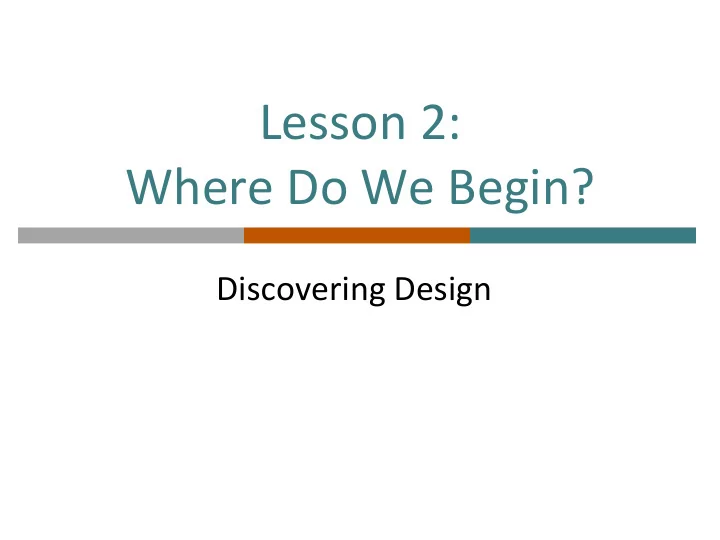

Lesson 2: Where Do We Begin? Discovering Design
Your Design Challenge Work in pairs to design and build a portable pinhole camera to be used by participants in an arts program for people with disabilities. Write this statement in your engineering notebook.
Naming the Steps of the Engineering Design Process Engineers use a structured process to solve design challenges. All design challenges start with a design challenge statement. Can we give a name to the “step” of receiving or creating a design challenge statement?
When we design for people, we must think about… User actions User needs These guide us toward what our These guide us toward what design should allow users to do. our design must do. Let’s start with these.
What does your customer need?
Analyze user needs – first need. Record on 4”x5” black and white What film paper a single image of a aspects of 10’x10’ square area from a distance the camera of no less than 5’ and no more than design 20’, filling the paper as much as does this possible without cutting off the affect? subject.
Remember that light travels in straight lines. Recall your notes on the camera obscura
The image in the camera changes with camera distance. What happens as the camera is moved closer to the object? Farther from it?
The image in the camera changes with film position. What if the camera stays still and the film paper moves inside the camera? Engineers would use math and science, not just trial- and-error , to figure out where to put the film and place the camera. You should, too!
Let’s Consider an Example: Film Placement Suppose that you want to make a pinhole camera from a 12”x5”x7” box and use it to photograph the side of a 5’x5’x14’ car from no farther than 35’ away using 2”x3” film paper. You want the image to fill the film paper without being cut off. If you are going to affix the film paper to one side of the box, what are your options for that placement? How far would you have to be from the car to get the desired image? Work with your partner to explain your reasoning and draw a model of the situation.
Example: Film Placement Which dimensions of the car matter? 5’ 14’ 5’
Example: Film Placement What would models for height and length look like? Subject Camera
Example: Film Placement What would models for height and length look like? 14’ 3” Film length ≤ 35’ Car length Camera Distance
Example: Film Placement What would models for height and length look like? 5’ 2 ” Film height Car height ≤ 35’ Camera Distance
Example: Film Placement If needed, revise your geometric model(s) with your partner. Show either one 3-D model or two 2-D models. Show film paper, aperture, and subject Show height and width How can we determine the dimensions of the pinhole camera?
Optics models can be complex. Geometric/algebraic model using linear equations
Optics models can be simplified. Geometric model using similar triangles and proportionality
Example: Film Placement Recall that, in this example, you want to make a pinhole camera from a 12”x5”x7” box and use it to photograph a 5’x5’x14’ car from no farther than 35’ away using 2”x3” film paper. You want the image to fill the film paper without being cut off. If you are going to affix the film paper to one side of the box, what are your options for that placement? How far would you have to be from the car to get the desired image? Write the problem statement, perform the calculations, and answer the questions in your engineering notebook.
Now determine the geometry of your camera. Use the model that you developed and used for the previous example to calculate the required dimensions of your own camera. What are your options for the focal length of your camera for this project? What can you say about the minimum or maximum size required for the container? Record this in your engineering notebook.
Notebook Check Place post-it notes on the appropriate pages in your notebook to denote the following items: User needs User actions Example model, calculations and answers My camera geometry, min/max size Write down the name of the appropriate item on each post-it. Place a post-it in your notebook for anything else you are particularly proud of or would like me to see.
What’s Next? User actions User needs These guide us toward what our These guide us toward what design should allow users to do. our design must do. We’ll continue to explore user needs… … which will make us look at user actions.
Recommend
More recommend